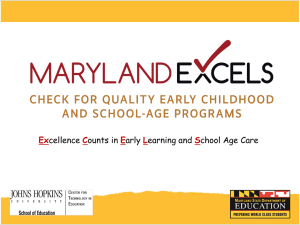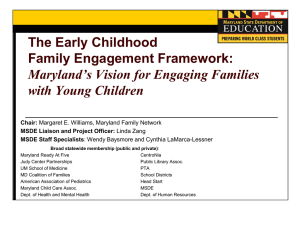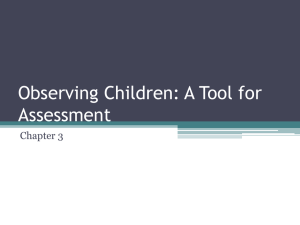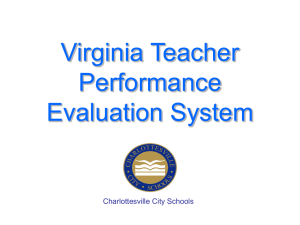Maryland EXCELS - Maryland State Department of Education
advertisement
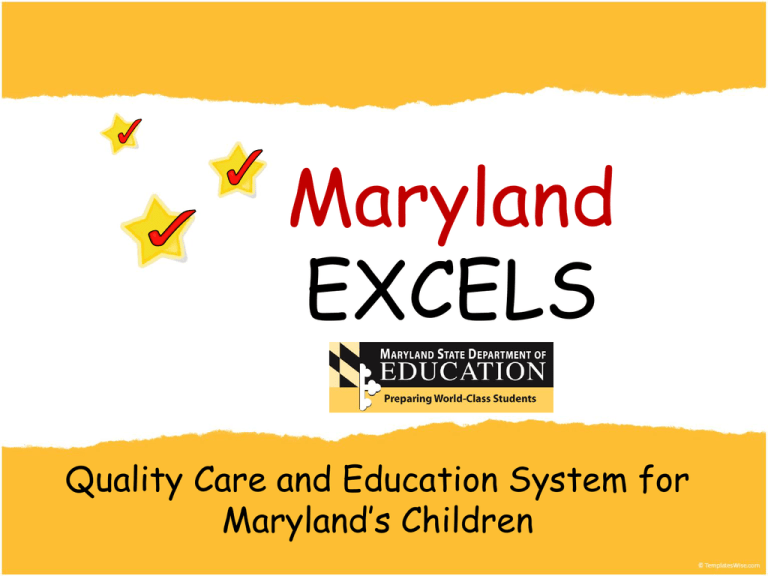
Maryland EXCELS Quality Care and Education System for Maryland’s Children Excellence Counts in Early Learning and School Age Care What is Maryland EXCELS? • Maryland EXCELS is a voluntary Tiered Quality Rating and Improvement System (TQRIS). • TQRIS programs award ratings to child care and public pre-K programs that meet increasingly higher standards in key areas of quality. What are the Goals of Maryland EXCELS? TO: • Recognize child care and public pre-K programs for meeting higher standards. • Encourage providers to increase the level of quality in their programs. • Provide parents with information and choices about quality child care. Purposes of Maryland EXCELS ASSESS Early learning experiences last a lifetime. Maryland EXCELS COMMUNICATE IMPROVE Licensing versus Maryland EXCELS Licensing - Required Maryland EXCELS - Voluntary A license to operate an early care and education facility is required by the state. Maryland EXCELS builds on licensing regulations. The first level is licensure status. As a participating provider in EXCELS, maintaining basic health and safety requirements is essential. Licensing regulations set the minimum standards to ensure that the basic health, safety, and developmental needs of children are being met. Maryland EXCELS requires that you take ownership and responsibility for selfevaluation, reflection, improvement, and demonstration of the quality of care provided. The Office of Child Care is responsible for issuing licenses, regulating child care, monitoring caregiver compliance with licensing requirements, conducting inspections, investigating complaints, and taking enforcement actions against programs found to be in violation of child care regulations. Through EXCELS, you determine your programs’ strengths and weaknesses, identify goals, and develop clear plans to achieve those goals. Finally, EXCELS provides the platform to share progress with parents, and gives parents and community members the knowledge to make informed decisions about child care arrangements. Benefits of Maryland EXCELS • Share information and resources • Advertise an EXCELS quality level. Demonstrating to families and the community at large that the program is committed to excellence and continually working toward higher standards. • Access to resources: o Program Coordinator - to provide guidance, support, and technical assistance as you progress through the steps. o Technical assistance from: – Maryland EXCELS Quality Assurance Specialists – The Maryland Child Care Resource Network, and – Breakthrough Centers • Financial incentives We’re here to help! State and Federal Investment Race to the Top - Early Learning Challenge - Project 2 Implement a Tiered Quality Rating and Improvement System for ALL Early Learning and Development Programs Funding: RTT-ELG Grant: Other funds (CCDF): Total for the next 4 years: $21,265,146 $12,683,136 $33,948,282 RTT-ELC Linkages with Maryland EXCELS Local Advisory Councils (Project 1) • Marketing • Promotion Revised Early Learning Standards (Project 4) Early Childhood Breakthrough Center (Project 3) • Training and Technical Assistance • Quality Capacity Building Project 2 (Project 6) • Formative Assessments • Kindergarten Entry Assessment • Incorporate Common Core Standards • Expand VIOLETS and STEM • Develop Guide to Early Pedagogy Early Childhood Data System (Project 10) Child Development Innovations (Project 7) • Developmental Screening Comprehensive Assessment System Coalition for Family Engagement (Project 8) • Customizing Family Engagement Framework for EXCELS standards • Child Care Administrative Tracking System • Maryland Longitudinal Data System Quality Assurance Specialists Quality Assurance Specialists will: • Conduct on-site monitoring and provide information on Maryland EXCELS. • Provide on-site consultation with participating programs to provide technical assistance, information and to verify the accuracy of Maryland EXCELS ratings. Maryland’s Standards • Licensing and Compliance • Rating Scales and Accreditation • Staffing and Professional Development • Developmentally Appropriate Learning and Practice • Administrative Practices and Policies The Charts Standard 3 4 5 The provider, director or designated staff person has visited or had a conversation with an accredited child care center within the past 12 months. Accreditation self-study is completed by program and an improvement plan developed on any standard not fully met. Program has completed the accreditation improvement plan. Request for accreditation validation visit submitted. Program has received a MSDE recognized Accreditation and remains in good standing with accrediting body. (Uploaded form signed by Director or Leadership from accredited child care center documenting visit.) (Uploaded statement of self- (Copy of Accreditation study completion and a copy of improvement plan and the improvement plan.) documentation that accreditation visit has been requested.) (Letter of Accreditation award from Accrediting agency, copy of annual report submitted to accrediting organization.) Self-assessment conducted using a recommended rating scale, such as ERS or CLASS, for at least one of each age grouping. Improvement plan created for any subscale score below 4.0 A recommended rating scale conducted for random sample including at least one classroom from all age groups. A recommended rating scale conducted for random sample including at least one classroom from all age groups. (Rating scale self-evaluation rating form and improvement plan.) (Rating scale score sheet completed by MSDE-approved evaluator and improvement plan.) Criteria 1 Doc Criteria 1 2 Criteria 2 Rating Scale CHECK LEVELS Doc ACCREDITATION Check 1 Level Rating Scale and Accreditation Category (not all standards are broken down into categories) Documentation Criteria Improvement plan created Improvement plan created for any subscale score for any subscale score below 4.5. below 5.0. (Rating scale score sheet completed by MSDE-approved evaluator and improvement plan.) Licensing and Compliance Criteria 1 (Valid license [CCATS]) (Valid license [CCATS]) 4 5 Fully licensed/registered and out of provisional period and/or conditional status. (Valid license [CCATS]) Criteria 2 Fully licensed/registered, open and operating for at least six months. 3 No substantiated complaints of No substantiated complaints of child abuse, neglect, or child abuse, neglect, or injurious injurious treatment in the last 12 months. treatment in the last 12 months. Criteria 3 Fully licensed/registered, open and operating. Doc 2 Adequate supervision and care at all times which is provided by qualified, designated individuals meeting all COMAR requirements and is appropriate to the individual child’s needs, while maintaining assignment of staff appropriate to both group size and age of children. Doc Licensing and Compliance 1 CHECK LEVELS (Inspection reports conducted within the past 12 months [CCATS and ELIS]) Adequate supervision and care at all times which is provided by qualified, designated individuals meeting all COMAR requirements and is appropriate to the individual child’s needs, while maintaining assignment of staff appropriate to both group size and age of children. (Inspection reports conducted within the past 12 months [CCATS and ELIS].) Criteria 1 Staffing & Professional Development Staffing and Professional Development 1 2 Family child care provider, director and all staff meet licensing requirements. At least 60% of lead staff hold a current Maryland Child Care Credential at Level 2 or higher, or the equivalent credentialing training for that level. CHECK LEVELS 3 4 5 At least 60% of lead staff hold a current Maryland Child Care Credential at Level 3 or higher, or the equivalent credentialing training for that level. At least 60% of lead staff hold a current Maryland Child Care Credential at Level 4 or higher. At least 60% of lead staff hold a current Maryland Child Care Credential at Level 4+ or higher. Doc (CCATS or uploaded (CCATS or uploaded (CCATS.) (CCATS.) training training certification for certification for staff members.) staff members.) Lead Staff = Family child care provider, Family child care Co-provider, Child care center director and teacher for each classroom. Levels 2-4 staffing criteria includes Administrator’s Credential Level 1. Level 5 staffing criteria includes Administrator’s Credential Level 2 or higher. Rating Scale and Accreditation Criteria 1 3 4 5 The provider, director or designated staff person has visited or had a conversation with an accredited child care center within the past 12 months. Accreditation self-study is completed by program and an improvement plan developed on any standard not fully met. Program has completed the accreditation improvement plan. Request for accreditation validation visit submitted. Program has received a MSDE recognized Accreditation and remains in good standing with accrediting body. (Letter of Accreditation award from Accrediting agency, copy of annual report submitted to accrediting organization.) Self-assessment conducted using a recommended rating scale, such as ERS or CLASS, for at least one of each age grouping. Improvement plan created for any subscale score below 4.0 A recommended rating scale conducted for random sample including at least one classroom from all age groups. A recommended rating scale conducted for random sample including at least one classroom from all age groups. (Rating scale self-evaluation rating form and improvement plan.) (Rating scale score sheet completed by MSDE-approved evaluator and improvement plan.) Criteria 1 Doc (Uploaded statement of self- (Copy of Accreditation study completion and a copy of improvement plan and the improvement plan.) documentation that accreditation visit has been requested.) Criteria 2 Rating Scale 2 Doc ACCREDITATION 1 CHECK LEVELS (Uploaded form signed by Director or Leadership from accredited child care center documenting visit.) Improvement plan created Improvement plan created for any subscale score for any subscale score below 4.5. below 5.0. ERS = Environment Rating Scale (Family Child Care, Infant/Toddler, Preschool, School-Age) CLASS = Classroom Assessment Scoring System (Head Start and Pre-K Classrooms) (Rating scale score sheet completed by MSDE-approved evaluator and improvement plan.) Environment Rating Scales are…. …”designed to assess process quality in an early childhood or school age care group. Process quality consists of the various interactions that go on in a classroom between staff and children, staff, parents, and other adults, among the children themselves, and the interactions children have with the many materials and activities in the environment, as well as those features, such as space, schedule and materials that support these interactions.” (Whitebook, Howes & Phillips, 1995). ERS = Environment Rating Scale (Family Child Care, Infant/Toddler, Preschool, School-Age) Developmentally Appropriate Learning & Practice -DAILY SCHEDULE- 2 3 4 5 The program has a daily schedule that is consistent, developmentally and ageappropriate, and responsive to the individual needs of all children. The program has a daily schedule that is consistent, developmentally and age appropriate, and responsive to the individual needs of all children, including children with disabilities, special health care needs and English learners. Daily schedule provides time and support for transitions. The program has a daily schedule that is consistent, developmentally and age appropriate, and responsive to the individual needs of all children, including children with disabilities, special health care needs and English learners. Written daily schedule includes plans for transitions. The program has a daily schedule that is consistent, developmentally and age appropriate, and responsive to the individual needs of all children, including children with disabilities, special health care needs and English learners. Written daily schedule includes plans for transitions. Daily schedule provides opportunities for indoor and outdoor activities on a daily basis. Daily schedule is responsive to the children’s needs to rest or be active and includes at minimum a total of 15 minutes of literacy/reading opportunities per half-day. Daily schedule provides opportunities for multiple indoor and outdoor activities on a daily basis. Daily schedule is responsive to the children’s needs to rest or be active and includes at minimum a total of 15 minutes of literacy/reading opportunities per half-day. No screen time for children under 2 years of age, and limited use of television or computers when not directly related to learning experiences. No screen time for children under 2 years of age, and limited use of television or computers when not directly related to learning experiences. Written daily schedules include plans for multiple daily indoor and outdoor activities, and flexible grouping opportunities. Daily schedule is responsive to the children’s needs to rest or be active, includes opportunities for gross motor physical activity and includes at minimum a total of 15 minutes of literacy/reading/library opportunities per half-day. No screen time for children under 2 years of age, and extremely limited use of television or computers when not directly related to learning experiences. Written daily schedules include plans for multiple daily indoor and outdoor activities, and flexible grouping opportunities. Daily schedule is responsive to the children’s needs to rest or be active, includes opportunities for gross motor physical activity and includes at minimum a total of 15 minutes of literacy/reading/library opportunities per half-day. No screen time for children under 2 years of age, and extremely limited use of television or computers when not directly related to learning experiences. Daily schedule provides time and support for transitions. Criteria 4 Criteria 3 Criteria 2 Criteria 1 The program has a daily schedule that is consistent and developmentally and age-appropriate for children in care. Criteria 5 Doc Developmentally Appropriate Learning, Practice - DAILY SCHEDULE 1 (Copy of daily schedule.) CHECK LEVELS (Copy of daily schedule and statement of policy regarding screen time.) (Copy of daily schedule and statement of (Copy of daily schedule and statement of (Copy of daily schedule and statement of policy regarding screen time.) policy regarding screen time.) policy regarding screen time.) Developmentally Appropriate Learning and Practice -CURRICULUM PLANNING- Criteria 1 Criteria 2 3 4 5 The program has a method for curriculum planning that includes planning from children’s interests and skills. The program has a method for curriculum planning that includes planning from children’s interests and skills and includes multiple literacy, language, science, art, health and wellness, physical fitness, and numeracy activities. The program has a method for curriculum planning that incorporates children’s interests and skills, and includes multiple literacy, language, science, art, health and wellness (including nutrition education and obesity prevention), physical fitness, and numeracy activities on a daily basis. The program has a written method for curriculum planning that incorporates children’s interests and skills, and includes multiple literacy, language, science, art, health and wellness (including nutrition education and obesity prevention), physical fitness, and numeracy activities on a daily basis. MSDE Healthy Beginnings, MMSR or approved curriculum guides the curriculum. MSDE Healthy Beginnings, MMSR or approved curriculum guides the curriculum. Implementation of a curriculum that is aligned with the MMSR and/or state curriculum. Implementation of a MSDE recommended curriculum that is aligned with the MMSR and/or state curriculum. The program has a plan for updating and rotating materials in library and activity areas. Criteria 3 2 The program has a plan for updating and rotating materials in library and activity areas. Evidence of differentiated instruction for each age group, children with disabilities, special health care needs and/or English learners. Criteria 4 Doc Developmentally Appropriate Learning and Practice - CURRICULUM PLANNING 1 CHECK LEVELS (Written description of curriculum planning process, sample lesson plan.) (Written description of curriculum planning process, representative recent lesson plan.) Evidence of differentiated instruction for each age group, children with disabilities, special health care needs and/or English learners. Evidence of use of an IFSP/IEP for individualized planning for children with disabilities (if applicable). (Written description of curriculum (Written description of curriculum planning process; recent lesson plan for planning process, including evidence of each age group served.) differentiated instruction, recent lesson plan for each age group served.) Developmentally Appropriate Learning and Practice Criteria 1 2 Developmental screenings conducted on all children (Birth through age 5) within 45 days of admission and at scheduled intervals as determined by MSDE. (Required after July 2014) Developmental screenings conducted on all children (Birth through age 5) within 45 days of admission and at scheduled intervals as determined by MSDE. (Required after July 2014) Children are observed for developmental progress. Criteria 2 1 CHECK LEVELS 3 4 Developmental screenings conducted on all children (Birth through age 5) within 45 days of admission and at scheduled intervals as determined by MSDE. (Required after July 2014) Children are observed for developmental progress using developmental checklists. Developmental screenings conducted on all children (Birth through age 5) within 45 days of admission and at scheduled intervals as determined by MSDE. (Required after July 2014) Children are observed for developmental progress and the program has a policy regarding child assessment using developmental checklists or assessments designed for use with the curriculum. The program has a policy for sharing assessment results with families. Criteria 3 Documentation Developmentally Appropriate Learning and Practice - ASSESSMENT -ASSESSMENT- (Statement of Early Childhood Developmental Screen (ECDS) policies, practices and sharing of results.) (Statement of ECDS policies, practices, sharing of results and written description of assessment practices.) (Statement of ECDS policies, practices, sharing of results and written description of assessment practices.) (Statement of ECDS policies, practices, sharing of results and written description of assessment practices, including sample child assessment measures, copy of written policy for sharing assessment results.) 5 Developmental screenings conducted on all children (Birth through age 5) within 45 days of admission and at scheduled intervals as determined by MSDE. (Required after July 2014) Children are observed for developmental progress and the program has a written policy regarding child assessment using developmental checklists or assessments designed for use with the curriculum, including formal and informal assessment measures, including developmental checklists, portfolio development, and observation/anecdotal records. The program has a written policy that describes their practices for sharing assessment results with families (which includes meeting at least once a year) and/or agencies that may be working with the family, including early intervention or special education services. (Statement of ECDS policies, practices, sharing of results and written description of assessment practices, including sample child assessment measures, copy of written policy for sharing assessment results.) Developmental Screening Tools Instrument Ages and Stages Questionnaire (ASQ) -2nd Ed. http://agesandstages.com/ Parents’ Evaluations of Developmental Status (PEDS) http://www.pedstest.com/ Early Screening Inventory – Revised (ESI-R) Best Beginnings Developmental Screen (BBDS) Age Range Birth to 60 months Time Frame ~15-20 minutes, less if parents complete independently (each questionnaire takes 10-20 minutes to complete, with 2-3 minutes to score) Administration Parents, home visitors, other providers, Requires a 6th grade reading level. Professionals score the questionnaires. Birth to 8 years 2-10 minutes, less if parents complete independently Written at the 4th to 5th grade level, parents can complete the measure while they wait for appointments. 3-6 years 15 – 20 minutes Birth to 39 months 10-12 minutes Individuals who have some background in early childhood behavior and development can administer the scale, such as teachers, students of child development, school psychologists, or allied health professionals. Experienced paraprofessionals have also been successfully trained to administer the scale. Provider and parents who have background can administer the scale Screen is complimented by Family Questionnaire. 1 2 3 The program has a parent handbook/contract that includes at a minimum the program’s policies and practices for health and safety and tuition/enrollment procedures. The program has a parent handbook/contract that includes at a minimum the program’s mission and/or philosophy statement, and policies and practices for health and safety and tuition/enrollment procedures, inclusion of children with disabilities or special health care needs and behavior management. The program has a parent handbook/contract that includes written policies on the program philosophy or mission, policies and practices, and at least 4 of the following: communicating with families, health and safety information, wellness, physical fitness and nutrition, emergency plans, tuition and enrollment policies, teaching and learning, inclusion of children with disabilities or special health care needs and behavior management. The program provides the parent handbook to all parents prior to enrollment and requires written receipt of outlined policies and procedures. The program has a parent handbook/contract that includes written policies on the program philosophy or mission, policies and practices, including communicating with families, health and safety information, wellness, physical fitness and nutrition, emergency plans, tuition and enrollment policies, teaching and learning, inclusion of children with disabilities or special health care needs and behavior management. (Copy of parent handbook.) (Copy of parent handbook and one signed notification.) (Copy of parent handbook and one signed notification.) (Copy of parent handbook.) (Copy of parent handbook.) 4 If eligible, the program participates If eligible, the program participates in the Child in the Child and Adult Care Food and Adult Care Food Program. Program. Doc Families are provided with opportunities to be involved in the program in at least two ways. 5 The program provides the parent handbook to all parents prior to enrollment and requires written receipt of outlined policies and procedures. If eligible, the program participates in the Child and Adult Care Food Program. Fresh fruits and/or vegetables are provided at least twice a week, and meals provided from home are monitored and supplemented as necessary to ensure that children are receiving nutritious, balanced meals. Fresh fruits and/or vegetables are provided at least twice a week, and meals provided from home are monitored and supplemented as necessary to ensure that children are receiving nutritious, balanced meals. (Documentation of CACFP participation.) (Documentation of CACFP participation. Copy of a weekly menu served within the past month.) (Documentation of CACFP participation. Copy of a weekly menu served within the past month.) Families are provided with opportunities to be involved in the program in at least three ways. Families are provided with opportunities to be involved in the program in at least four ways, including (but not limited to) field trips, activities, fundraising, decision-making, parent newsletters, or parent surveys. Program conducts family conferences based on the developmental screening schedule. Families are provided with opportunities to be involved in the program in at least five ways, including (but not limited to) field trips, activities, fundraising, decision-making, parent newsletters, or parent surveys. Program conducts family conferences based on the developmental screening schedule. Program requests a copy of a child's IFSP/IEP (if applicable) and works with early intervention or special education service providers to support child and family outcomes. Program requests a copy of a child's IFSP/IEP (if applicable) and works with early intervention or special education service providers to support child and family outcomes. Criteria 4 Criteria 3 Doc Criteria 2 CHECK LEVELS The program has a parent handbook/contract that includes at a minimum the program’s policies and practices for health and safety and tuition/enrollment procedures. Criteria 5 Criteria 7 Criteria 6 Doc Administrative Practices and Policies – FAMILIES Criteria 1 Administrative Practices and Policies -FAMILIES- Program conducts family conferences based on the developmental screening schedule. Program conducts family Program conducts family conferences based on the conferences based on the developmental screening developmental screening schedule. schedule. (Copy of conference schedule.) (Examples of at least two family involvement activities and conference schedule.) (Examples of at least three family involvement activities and conference schedule.) (Examples of at least four family involvement activities and conference schedule.) (Examples of at least five family involvement activities and conference schedule.) Administrative Practices and Policies -STAFFCriteria 2 Doc 3 The program holds monthly staff meetings. Staff performance is Staff performance is evaluated in evaluated in writing at least writing at least annually, and as needed annually. for professional improvement. Staff performance is evaluated in writing at least annually, and as needed for professional improvement. (Copy of staff meeting and performance evaluation schedule.) (Copy of staff meeting and performance evaluation schedule and a copy of the performance evaluation tool.) (Copy of staff meeting and performance evaluation schedule and one completed (name redacted) performance evaluation.) The program has developed staff policies. The program has developed The program has a written staff a written staff handbook. handbook provided to all new staff members at hire, which includes policies and procedures related to health, safety, child development, inclusion of children with disabilities and special health care needs, training, behavior management, staff expectations, and benefits. Criteria 3 2 The program holds at least 4 staff meetings per year. Staff performance is evaluated at least annually. (Statement of staff policies.) 4 The program holds monthly staff meetings. (Copy of staff meeting and performance evaluation schedule and a copy of the performance evaluation tool.) 5 The program holds monthly staff meetings. The program has a written staff handbook provided to all new staff members at hire, which includes policies and procedures related to health, safety, child development, inclusion of children with disabilities and special health care needs, training, behavior management, staff expectations, and benefits. The program maintains written receipt of staff handbook from all employees. The program maintains written receipt of staff handbook from all employees. (Copy of staff handbook.) (Copy of staff handbook, including at least one signed notification.) (Copy of staff handbook, including at least one signed notification.) Incremental salary scale based on education and experience. The program has an incremental salary The program has an incremental salary scale based on education and experience scale based on education and experience and other benefits. and other benefits. Criteria 4 Doc Doc Criteria 5 Administrative Practices and Policies - STAFF Criteria 1 1 CHECK LEVELS (Copy of current salary scale.) (Copy of current salary scale; description of benefits.) (Copy of current salary scale; description of benefits.) (Applies to Child Care Centers and Family Child Care Providers with Employees) Administrative Practices and Policies -COMMUNITY5 Criteria 2 The program maintains current and accurate information about community resources and referral sources, including referral sources and access to programs for children with disabilities and special health care needs. The program accesses local resources, including local public library services. The program maintains current and accurate information about community resources and referral sources, including referral sources and access to programs for children with disabilities and special health care needs. The program accesses local resources, including local public library services. Criteria 3 The program provides information to The program provides information to families about community resources families about community resources and referral services. and referral services. Criteria 4 Doc Criteria 1 4 Doc Administrative Practices and Policies - COMMUNITY 1 CHECK LEVELS 2 3 The program maintains current and accurate information about community resources and referral sources. The program maintains current and accurate information about community resources and referral sources. (Statement of how program identifies community resources and updating protocol.) (Statement of how program identifies community resources and updating protocol.) (Statement of how program: identifies community resources and updating protocol: and resource information provided to families.) (Statement of how program: identifies community resources and updating protocol: and resource information provided to families.) The program has a plan for transitioning children from classroom to classroom and from center to school. The program has a plan for transitioning children from classroom to classroom and from center to school. (Copy of transition protocol(s).) (Copy of transition protocol(s).) The program has a plan for transitioning children from classroom to classroom and from center to school. The program has a policy for supporting the transition of children with disabilities and special health care needs (if applicable). (Copy of transition protocol(s).) Maryland EXCELS Website http://MarylandExcels.org Maryland EXCELS Website Incentives • Program Bonuses - awarded to participating programs based on the Check Level rating. Family Child Care Homes Child Care Centers Large Family Child Care Homes Check Level Bonus Amount Check Level Bonus Amount 1* 2* 3* 4* 5* $ 50 $ 150 $ 300 $ 500 $ 800 1* 2* 3* 4* 5* $50 $200 $400 $800 $1,000 Check Level Capacity 1-50 Capacity 51-100 Capacity 101+ 1* 2* 3* 4* 5* $50 $250 $400 $1,000 $1,500 $100 $500 $800 $2,000 $3,000 $150 $750 $1,200 $3,000 $4,500 *Frequency and Amount of Bonus payments to participating programs: Levels 1-3 - one time only upon attainment of Check Level Levels 4 & 5 – full amount upon attainment, frequency and on-going amount to be determined. • Incentives, Grants and Supports - participating programs and their staff (if applicable) have access to quality improvement incentives, grants and supports. • Credential Bonuses – full bonus amounts are available to the participating providers and staff. • Tiered Reimbursement – additional funding for each child receiving child care subsidy (Levels 3-5) Process and Next Steps • Fall 2010 – Develop workbook, application process • Early 2011 - Disseminate information to gain feedback on standards, materials and process • Fall 2011 - Develop website • Fall 2011-Spring 2012 - Pilot • Fall 2012-Spring 2013 - Field Test • July 1, 2013 – Statewide Implementation Web-Site: www.MarylandExcels.org E-mail: mdexcels@msde.state.md.us excelssupport@mail.cte.jhu.edu
